AMD A10-5800K & A8-5600K Review: Trinity on the Desktop, Part 2
by Anand Lal Shimpi on October 2, 2012 1:45 AM ESTContent Creation Performance
Adobe Photoshop CS4
To measure performance under Photoshop CS4 we turn to the Retouch Artists’ Speed Test. The test does basic photo editing; there are a couple of color space conversions, many layer creations, color curve adjustment, image and canvas size adjustment, unsharp mask, and finally a gaussian blur performed on the entire image.
The whole process is timed and thanks to the use of Intel's X25-M SSD as our test bed hard drive, performance is far more predictable than back when we used to test on mechanical disks.
Time is reported in seconds and the lower numbers mean better performance. The test is multithreaded and can hit all four cores in a quad-core machine.
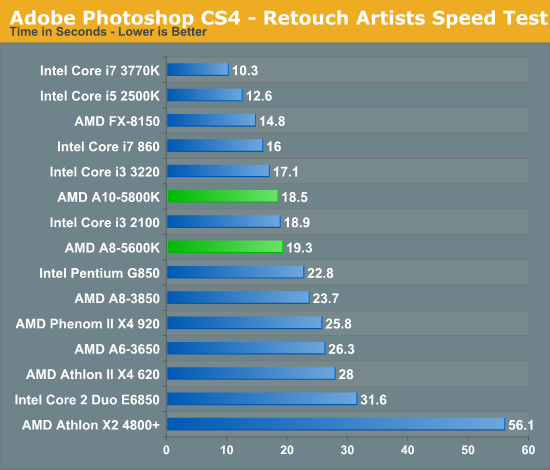
Our Photoshop workload still runs better on Intel hardware, but the gap in performance between the 5800K and 3220 is smaller than it was between the FX-8150 and 2500K last year. While Bulldozer was pretty much unrecommendable, Trinity approaches tradeoff territory.
3dsmax 9 & POV-ray
Today's desktop processors are more than fast enough to do professional level 3D rendering at home. To look at performance under 3dsmax we ran the SPECapc 3dsmax 8 benchmark (only the CPU rendering tests) under 3dsmax 9 SP1. The results reported are the rendering composite scores.
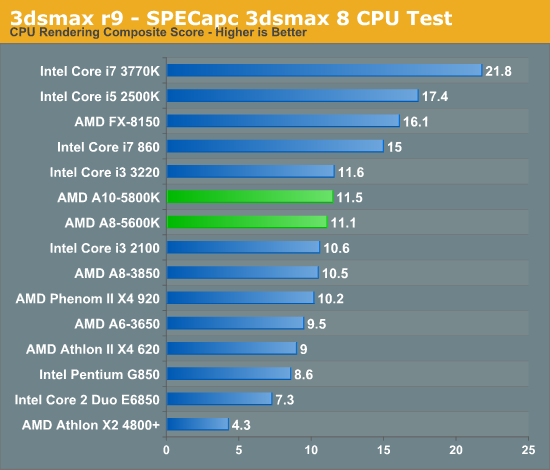
Once again in a heavily threaded FP benchmark, the A10 and Core i3 perform very similarly. POV-Ray is another example of this below:
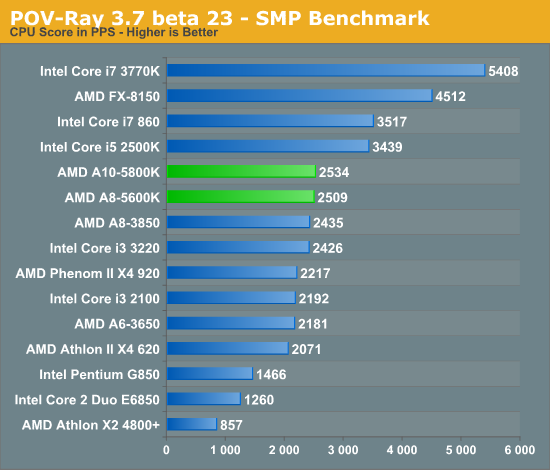
File Compression/Decompression Performance
Par2 is an application used for reconstructing downloaded archives. It can generate parity data from a given archive and later use it to recover the archive
Chuchusoft took the source code of par2cmdline 0.4 and parallelized it using Intel’s Threading Building Blocks 2.1. The result is a version of par2cmdline that can spawn multiple threads to repair par2 archives. For this test we took a 708MB archive, corrupted nearly 60MB of it, and used the multithreaded par2cmdline to recover it. The scores reported are the repair and recover time in seconds.
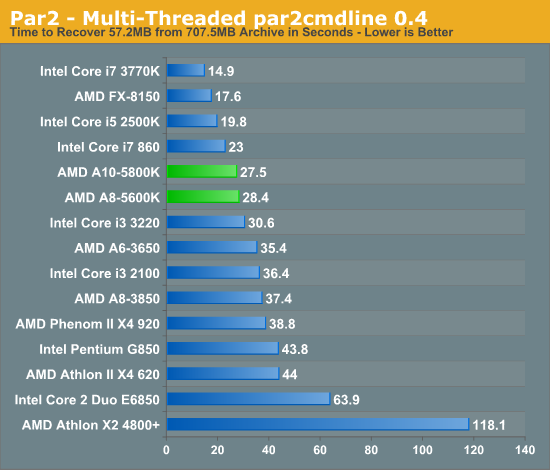
Our multithreaded Par2 recovery test shows AMD with a small advantage over the Core i3 3220, although it obviously can't touch any of the more expensive quad-core parts.
Excel Math Performance
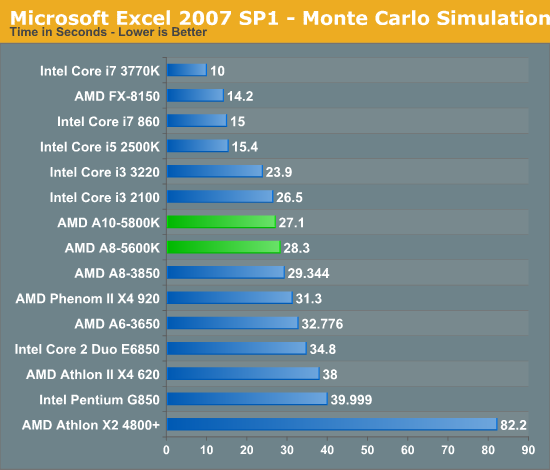
Not all heavily threaded FP applications are easy wins for AMD. In our Monte Carlo simulation benchmark the 3220 manages a decent lead over the A10-5800K.
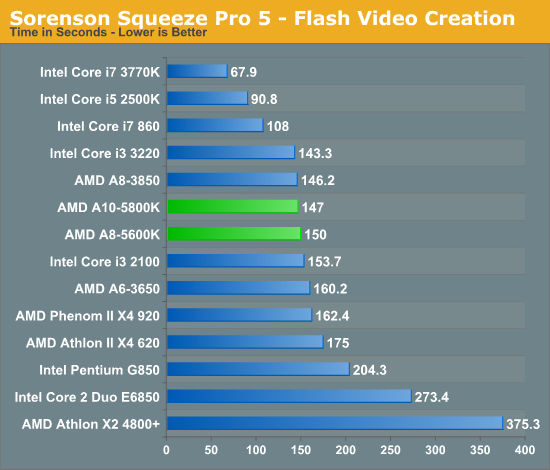
Our old Sorenson Squeeze test is one area where we see a slight regression compared to Llano. Like I mentioned earlier, this isn't super common but it does happen from time to time given the dramatic architecture difference between Llano and Trinity.










178 Comments
View All Comments
MySchizoBuddy - Tuesday, October 2, 2012 - link
with Corsair H100 water cooler they were able to overclock it to 5GHz stable.mikato - Wednesday, October 3, 2012 - link
Sounds legit.MySchizoBuddy - Tuesday, October 2, 2012 - link
Can the GPU be overclocked or is it just for the CPUMedallish - Tuesday, October 2, 2012 - link
AMD did a preview where they showed off an overclocked APU with the GPU pushed up to 1GHz, so I'm pretty sure it should be possible, but it might be a feature exclusive to some motherboards or chipsets.Doby - Tuesday, October 2, 2012 - link
I don't understand why the load power is more important than idle. I don't know about most people, but I don't turn off any of the 3 desktops/media center PCs I have in the house, but I do know the majority of the time they sit idle. I haven't done the math, but I would bet quite a bit of money that over all I will spend less on my power bill by having a lower idle than having lower at load power draw.I could see the issue on portable machines running off battery, but even then running full out is unlikely, and it becomes a "hurry up and wait" scenario that probably requires better analysis.
I feel like benchmark performance is a bit over rated, we need to see value the consumer can leverage. I want to know which one "feels" faster, likelihood of running into application issues such as graphics drives, large displays, or even stability problems. I want to know what I can recommend to my parents for a basic internet PC. Even if I was doing video transcoding I'm not sitting around waiting for it, if it takes more than 30 seconds I'm up not waiting for it, it might as well be 5 min.
I know its easier to just post a bunch of benchmarks, and I do still like to see them. But lets progress computing to the next level, user experience. I'm fine with a "doesn't make a difference" answer too, but that's still better than "12% faster for a process that you won't wait for anyway".
Don't get me wrong, I enjoy the article, and appreciate the write up. Just looking for a bit different education.
Visual - Tuesday, October 2, 2012 - link
I don't worry about power bills from running 24/7 idle. I have enough other devices at home that a PC wouldn't make a dent either way. But I do prefer if the computer cooling was not heard throughout the apartment.Power use under max load is important in selecting the case and cooling system, etc. You may load it that much only for a few minutes, but your setup still needs to handle that "worst case" situation. And if you are going for a quiet setup, it would be no comfort for you if it is quiet when not used, but racks up the noise and begins to bother you when you start using it.
halbhh2 - Tuesday, October 2, 2012 - link
Great questions, and we can see that the idle power draw of the A10 is good, and so it would make a good choice for typical use (which is 80-85% idle) for a typical use laptop, and it would do well obviously in playing many games, and can potentially do this at a reasonable cost (depending on the OEM maker, like HP). So, just like you, I wonder how long the typical battery run time is. That's how I bought my yr-old HP laptop -- just typical battery run time and a good display, and good price. I knew enough to know those were the parameters that would matter for our laptop, and it would be okay at occasional demanding use just as you describe -- when it takes more than 20-30 seconds, you are off doing something else anyway.Hubb1e - Tuesday, October 2, 2012 - link
Doby, I agree with you. I think it really comes down to a yes or no question on each use case. Benchmarks are nice, but i3s and A10s are really not enthusiast level CPUs so 12% single threaded advantage doesn't matter in the long run. The question to ask is "Can it run my applications"And in the case of Trinity vs i3 the main difference is that it can play games while the i3 with HD2500 graphics can't. If you look at Diablo 3, that game was played by a lot of people that are not traditionally PC gamers. An i3 with HD2500 is barely playable while Trinity is a pleasure to use on Diablo 3. For most PC buyers I think Trinity makes a lot of sense where idle power matters most, CPU performance is competitive, and gaming is possible. People who buy off the shelf PCs are not that comfortable putting a GPU in their rigs so Trinity is a good option for a general use PC. Enthusiasts who aren't AMD fanatics will stay away from this chip and that's fine. It will be a sales success for AMD if they can make enough profit on it. It is a pretty big chip...
Roland00Address - Tuesday, October 2, 2012 - link
The reason why idle is unimportant for desktop is that both companies processors idle at such an insignificant amount.The Amd a10 idles 7 watts lower than the i3 and i5.
1 watt used 24 hours a day 7 days a week is 8.76 kWh thus we are talking about 61.32 kWh (7*8.76) a year. The cost per kWh is different in differnt places in the US but it is about 10 cents a kWh so we are talking about 6 dollars more a less in energy savings a year.
Aka talking about idle power is a virtually insignificant number for desktops. Now for laptops on the other hand it is a big deal for laptop idle power use affects battery life.
phoenix_rizzen - Tuesday, October 2, 2012 - link
If it's 8.76 kWh per week, should you be multiplying by 52 weeks in a year? Thus 455.52 kWh per year?